Ripping out or blowing away tents and canopies is a common scenario in the windy area. Before camping in strong wind locations, it’s recommended to learn the tricks to camp there
So, how to secure a tent in high winds? The process includes anchoring the tent with stakes and guylines, removing sidewalls and rainfly, etc. In this way, you can keep the tent or canopy from blowing away. This is also a safety factor in the wilderness.
This article will guide you to anchor the canopy or tent in the right way in the gale-force winds. Let’s read on!
Step By Step Canopy/Tent Pitching In Strong Winds
The stability of a tent in howling winds largely depends largely upon the tent pitching. If you fail, most likely the tent can’t deal with the strong wind. And you may experience an awkward situation at the campsite.
It’s important to follow the tent setup instructions provided by the tent manufacturer. Sometimes people skip the instructions manual and do it their own way. As a result, they don’t get the optimal stability of the tents against winds.
Thus, it’s recommended to learn the tent pitching method in gale-force winds. So, how to set up a tent in heavy winds?
How Do You secure a Tent in high winds?
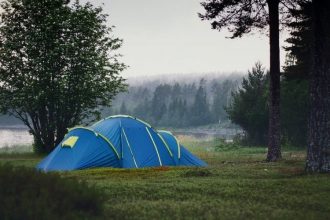
Pitching tents in gusts might be incredibly difficult, especially for the first-timers. But you can make the hard job fun by involving the whole family to do that. Absolutely, everyone loves this and gets a new experience.
The process of tent setup and securing strong winds can be completed following four main steps and several sub-steps.
- Preparation and bringing necessary things
- Spot selection
- Tent/canopy pitching
- Tent securing
Let’s discover the ways on how to secure a canopy in high winds.
Step 1: Bring The Right Camping Gear
To keep a canopy in place in gale-force winds you have to take the necessary things such as a strong wind tent, good poles, strong stakes, robust guy ropes, mallet, and more. Most importantly, you should choose the following items carefully.
1.1 Tent/Canopy Selection for Strong winds
To be safe in the mountain, beach, or any windy location, you need a sturdy tent/canopy that is good wind resilient. So, when buying the best tent for high winds look for the utmost wind-rated one.
The low profile and fewer wall tents stand up well against heavy winds. If the peak or walls are tall enough, winds can knock it down. Besides these, when buying a good tent for strong winds, consider its size and pole importantly.
Shape of heavy winds tents
Dome tent like this Sundome Coleman is proved to be great for resisting strong wind. A geodesic tent is an unparalleled option among dome shapes for extreme situations.
Numerous crisscross poles make this tent great to use on the beach or in heavy winds. However, you can make this tent more stable using guy lines and stakes.
The tunnel shape tent is a pretty good choice for wind resistance. This allows easy wind passing so the tent will not blow away in winds. Still, pegs and guy ropes anchor down this tent and stand out firmly against the gusts.
If you need suggestions for high wind tents, here is a good one for your family camping.
Editor’s Choice: Best Tent For High Winds
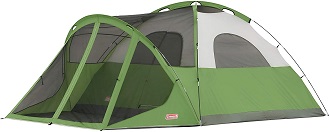
Coleman Evanston Dome Tent comes with high wind ratings. It uses strong frame poles and guy-outs to withstand gusts. This can easily take 40 mph winds even more.
Evanston is a polyester-made tent that uses the WeatherTec system that makes this camping tent weatherproof. Moreover, included rainfly will add extra protection.
There is a screen room that will keep you safe from bugs and insects. Besides, you can enjoy the outside scenery. The roomy interior allows 2 queen size air beds. An additional porch allows you to keep shoes, even sitting or sleeping on a hot night.
Large windows of the tent maintain good airflow inside. The zipper door adds weather protection. Storage pockets allow keeping small necessaries beforehand.
Overall consideration, everything is included in this affordable high-wind tent. So, don’t miss this all in all features wind-resistance tent.
Tent Pole Selection
Durable pole selection is also crucial like tent shape. Fiberglass poles provide flexibility and are lightweight enough which makes them good to use in tents where wind flow is a matter of concern. They are also affordable to purchase.
But heavy gusts might break them sometimes. You can fix them using duct tape, but they are useless in harsh environments.
Instead of fiberglass poles, the aluminum poles come with better features. They are flexible and difficult to break. Although they are expensive than fiberglass, still they will be the most convenient choice for heavy winds to the beach and mountain.
Now have a look at some of the strongest tents and canopies to camp in heavy wind spots.
1.2 Choosing The Best tent Pegs
Tent pegs or stakes selection is the most important thing that will help you to anchor the tent in the right way. There are many factors to choose the right tent stakes for high winds.
Material of Tent Stakes
Usually, tent stakes are made from plastic, steel, aluminum, titanium, etc.
Steel is the widely held pegs to any ground and provides better anchoring than woods and plastics. But they are heavier than others. Keep in mind that galvanized steel pegs provide long-lasting performance.
Plastic pegs are the lightweight and cheapest tent stakes to buy. For sandy grounds, they are the most suitable option. However, they can’t deal with powerful winds.
Aluminum tent ground stakes are stronger than plastic but softer than steel pegs. Backpackers love this for a lightweight feature and works well for rocky grounds. Still, they bend in heavy winds.
Titanium tent stakes are the most durable pegs but they are pricier than others. And titanium pegs are lighter than steel stakes and can withstand the highest winds.
Pegs Shape
Tent anchoring pegs are available in versatile shapes like T-shape, V-shape, Y-shape, Auger, corkscrew, and much more.
T-shape or nail pegs have tip end with a flat head. They are good for small tents.
Y-shape tent stakes are perfect choice for any ground. Due to their shape, they are hard to bend that make them ideal for hard and rocky grounds. They are heavier than others that make them resilient against gale-force winds.
V-shape tent anchors are versatile ground usable pegs for tent securing in the powerful wind blowing. These stakes go into the earth easily and provide great stability to the tent. The shaft holes of the pegs allow threading the guy lines.
Corkscrew tent stakes are similar to spiral screws. Due to their jagged shape, they provide good surface grip and won’t pull upwards easily. For this reason, they are considered one of the best tent pegs for sandy grounds.
Auger is a wonderful tent staking method. It consists of a V-shaped corkscrew shaft. This provides more durable anchoring than a corkscrew and V-shape stakes. Auger is ideal for sandy and snowy areas. And the shape makes this a little harder to insert and remove in the ground.
Anchor Length
Different tent stakes come in dissimilar sizes. Longer stakes go deeper and provide more stability than the shorter pegs. The length of tent pegs may vary from 5 to 15 inches. Choose the most suitable tent stakes according to the winds flow where you are going to camp.
Here is a durable and top-performing tent anchoring kit recommendation for you.
Editor’s Choice: Best Tent/Canopy Stakes For High Winds
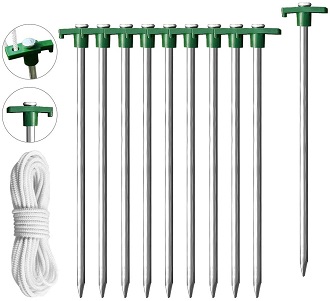
Eurmax Tent Stakes Set comes with 10 pieces of pegs, 4×10 ft ropes, and a stopper. The galvanized steel-made stakes last long without any rust formation. So, you can use the pegs set years after years.
Peg’s length is 10 inches and its width is 1/4 inches, thus it provides maximum stability of the tents against high winds. The manufacturer recommends using the pegs at 60 degrees angle to get maximum protection.
Eurmax tent pegs have multipurpose uses that fit for anchoring canopies, tents, patios, gazebos, and many more fields. We believe, this tent peg set will be an unmatched choice for securing your canopy or tent in gale-force winds.
Step 2: Check Wind Direction & Choose A Safe Spot
Try to pitch your tent in a minimal windy area. Setting up the tent in an open location will increase the chance of blowing away the tent as the tent is exposed to strong winds from all sides.
So, determine the wind flow direction and find out the least windy spot. You can use a wind vane to know the wind direction. Also, choose a ground where you get wind resistance elements.
Different things may work as wind-blocks in the wilderness such as trees, the ridge of rocks, the side of hills, the downwind of the ridge, the hedge of bushes, or any other natural or artificial windbreaker.
Besides, point back the tent to its lowest and narrowest side towards the wind to avoid excessive wind blows. Never place the door side against winds coming, this may throw away the tent.
Make sure, you aren’t set up the tent near-dead tree trunks or broken branches, as they might fall upon the tent any time and can create a serious accident.
After selecting the right camping location and let’s move on to the next step.
Step 3: Lay Out Components & Assemble Poles
Unzip the tent bag and lay out the components loosely on the ground. Before that, you can sweep the ground to clean the tent place.
Now lay out the ground tarp and top tarp of the tent. Then arrange the tent poles by attaching one to another. And organize them with the top tarp until you get the full tent shape.
Step 4: Anchoring Tent Using Stakes/Pegs
To prevent your tent from blowing away, it’s necessary to stake it down. Start from the windward side. Then go in the opposite direction. You may need a mallet while staking, especially if the ground is hard or rocky.
Make sure the stakes go deep into the ground. Never put the stakes straight. For better stability, stake at 45 degrees angles. If the ground isn’t ideal for staking or stakes aren’t strong as your expectation, then use sand anchors or rocks for increasing tent steadiness. You can also use bungee cords for adding stability.
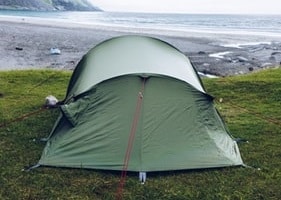
Step 5: Secure Tent with Guy lines
Guy ropes are another important thing to increase tent strength. Guy lines are attached to the rainfly. Pull the rain fly tightly and anchor the guy ropes from a short distance of the tent. Make sure, you anchored opposite to wind direction to add more durability.
Proper knotting can be the game changer here. So, before camping in high winds, learn some basic and good knots. But sailing knots might be most effective in heavy wind locations.
Step 6: Don’t Forget To Close The Door and Windows
You have already installed high wind tent stakes and guy ropes, still close all the tent and canopy doors and windows to stop the shelter from flying away.
Step 7: Weigh Down The Tent
It is always good to weigh down the tent or canopy how much you can. So, you can put some heavy camping gear inside the tent or tie them with tent, these will extend the stability of the tent against strong winds.
Two more steps to anchor the tent in extreme winds. Let’s do this!
Step 8: Remove the Sidewalls
If you are camping in the exposed area, winds may strike directly to the sidewalls. In this case, you can remove the sidewalls to reduce the chance of blowing away your canopy. Nevertheless, if you need sidewalls, go for the windscreen sidewalls, not the tarp ones.
Step 9: Put Down The Rainfly
The rain fly is the external part of the tent that goes up the top tarp. This is one of the critical parts where the winds hit first. So, if there is no chance of rain, you can put this down to avoid the tent being blown away.
By following the above easy steps, you can easily reinforce your tent or canopy against heavy winds and keep your tent or canopy from blowing away.
The video below will help you understand how to stable your canopy against strong winds.
More Tips for Camping in High Winds – Do’s & Don’ts
1. Check The Weather Forecast
Camping in good weather can provide a nice camping experience. Alternatively, the bad weather may ruin your camping fun. But nature doesn’t cooperate according to our dream. Therefore, it’s good to know the weather forecast where you are planning camping, hiking, or other outdoor activities.
So, keep an eye on the weather. If the forecast tells hurricane, heavy rain, or any other serious weather hazard coming soon, stay at home, postpone the trip and pick another good day. It’s also important to know about the winds of the area so you can take necessary things with you for safe shelter.
Also Read: Is it okay to camp without a tent?
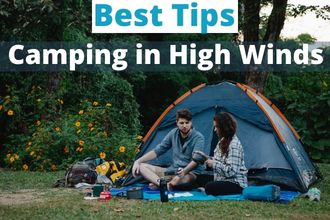
2. Don’t Go Alone
Solo camping in a windy location might be dangerous, particularly if you don’t have enough experience. The better option is to go in a group of two, three, or more. Sharing tasks in the windy area will ease your camping trip and you never feel lonely in the wilderness if any danger happens.
Read: Tent for 6-8 person review
3. Be Prepared for Repairs
When any part of your sustainable tent gets damaged, repair it immediately. For example, poles might get broken, tent tarps or sidewalls might rip out, or stakes might pull out due to powerful wind.
If these happen to you, repair them as soon as you can for upholding the tent’s strength. Check out this list of tent repairing kits>>>.
4. Don’t Allow Campfire
Typically campers prefer a campfire for heat and cook. But campfires set up in the windy area can be hazardous. Still, if you badly need of burning fire, you can do it in the far and opposite to the tent and wind direction. But keep your eyes open and turn it off soon. And if the wind is very strong, never set up a campfire there.
Read Also: Tips to keep snakes away from tents
5. Arranging Tent in Winds
Organizing a tent while camping in the winds is nothing very special. But this might be helpful for beginners. Place the heavy units such as storage crates, toolboxes, etc, in the corner of the tent so that their load help to weigh down the groundsheet from billowing up in winds.
The kitchen items, tables, should be kept away from edges to avoid buffeting and flipping over. Avoid hanging lanterns from the tent ceiling in the strong winds. Rather than you can use modern LED light. And potential accident occurring things and fire ignition items should be kept outside in the stormy situation.
6. Never Let Strove Inside
To get warm or cook some warm meal or snacks inside the tent is necessary for camping. But, don’t do this while there are stormy winds outside.
Doing this, you can face asphyxiation, which might be hazardous in the tent. Avoid this and get cover yourself with a blanket or get inside the sleeping bag. This will make you warm soon.
7. Fun Things To Do While Camping in Storm
If you face any stormy situation while camping, stay in the tent and avoid getting outside. And make sure that kids are playing inside the tent. You can do some fun things while sitting in the tent.
These include reading books, telling stories, crossword games, card playing, planning for fishing or hunting, etc. By doing this you can pass productive time there without getting bored.
Also Read: Tents with LED lights
Frequently Asked Questions
Q: Can a tent withstand 50 mph winds?
Answer: This is a commonly asked question by novice campers. This is asked in another way, how much wind can the tent withstand? Typically, most tents for high wind and rain can withstand 30 to 40 mph (miles per hour) wind maximum.
The rule of thumb is when the wind blows beyond this wind rating, the tent collapse. However, some top-engineered large tents can withstand 60 to 80 mph winds.
Read: Different parts of a tent
Q: How to secure a party tent in high winds?
Answer: To reinforce a party tent in extreme weather, you have to do some extra things besides the above-mentioned things. The most important ones are- tension the tent, remove sidewalls, using anti-sink tent plates.
Q: How much wind can a pop-up canopy take?
Answer: On average, a canopy tent can take 20 to 30 mph wind flow. Don’t worry, you can easily secure your canopy/shelter following the above-mentioned guidelines.
Q: How to take down a tent in heavy winds?
Answer: Well, this is actually the reverse action of securing tents in winds. But, while you are taking the pegs out, put some rocks on the tent top so that your tent won’t be blown away.
After that remove the guylines, but make sure you are removing guy ropes from upwind side last. So, when you completely remove all parts, pack them and store in the bag.
Q: Single or double-wall tent – which one is a better choice for windy conditions?
Answer: Whatever the tent you use, it is either a single-wall or a double-wall tent. And both of them have their own pros and cons. But which one is better in windy conditions. So, this is not a very important thing to consider.
Usually, double-skin tents give more sturdiness than single-wall tents. If the outer sheet rips, the inner part still provides protection.
However, both tents should be kept tight using the guy lines. This makes the tent stronger to withstand harsh weather either rain or wind.
Q: How can you prepare camping food in high winds?
Answer: While storming outside, it’s challenging to cook food and you might force to stay inside the tent. Even there is no way to boil water inside the tent. If the situation gets worse, the only thing you do is to eat dehydrated foods.
So, when planning from home take plenty of dry food, snacks, dry sausages, cheese, peanuts, etc.
Conclusion
By now you know how to secure a tent in high winds on a beach or other potential fields. While camping in the gusts, anchoring the tents is crucial. Whether you camp in a tent or canopy, don’t forget to take the best tent pegs or stakes in your camping bag to keep the shelter stable.
Let’s apply the methods that we discussed above to keep the tent in place. Hopefully, this will ensure your safe camping even in extreme weather. Have the best camping experience in powerful winds!

Joe is the founder and chief editor of PickOutdoorGear. He loves hiking, camping, fishing, hunting, and other outdoor activities. He will share his knowledge and experience here that he learned and still learning from the wilderness.

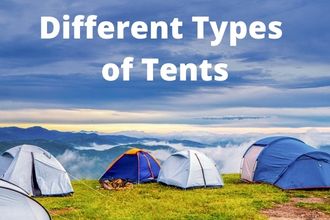
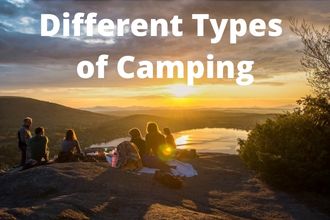

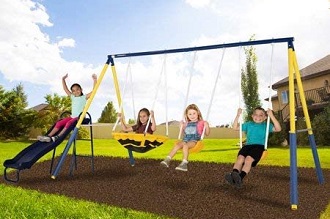
Is anyone in a position to recommend some good tent anchoring kit? Thanks 😀
Thank you for putting some words here! Please re-check this article. We already mentioned several top options.
This is my first time on your blog. Thanks for permitting me to remark!
Amazing article presentation! Keep it up!